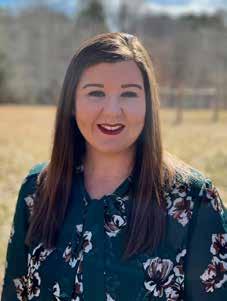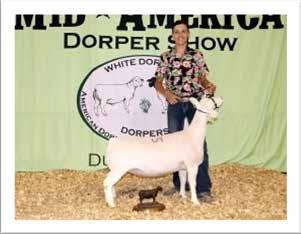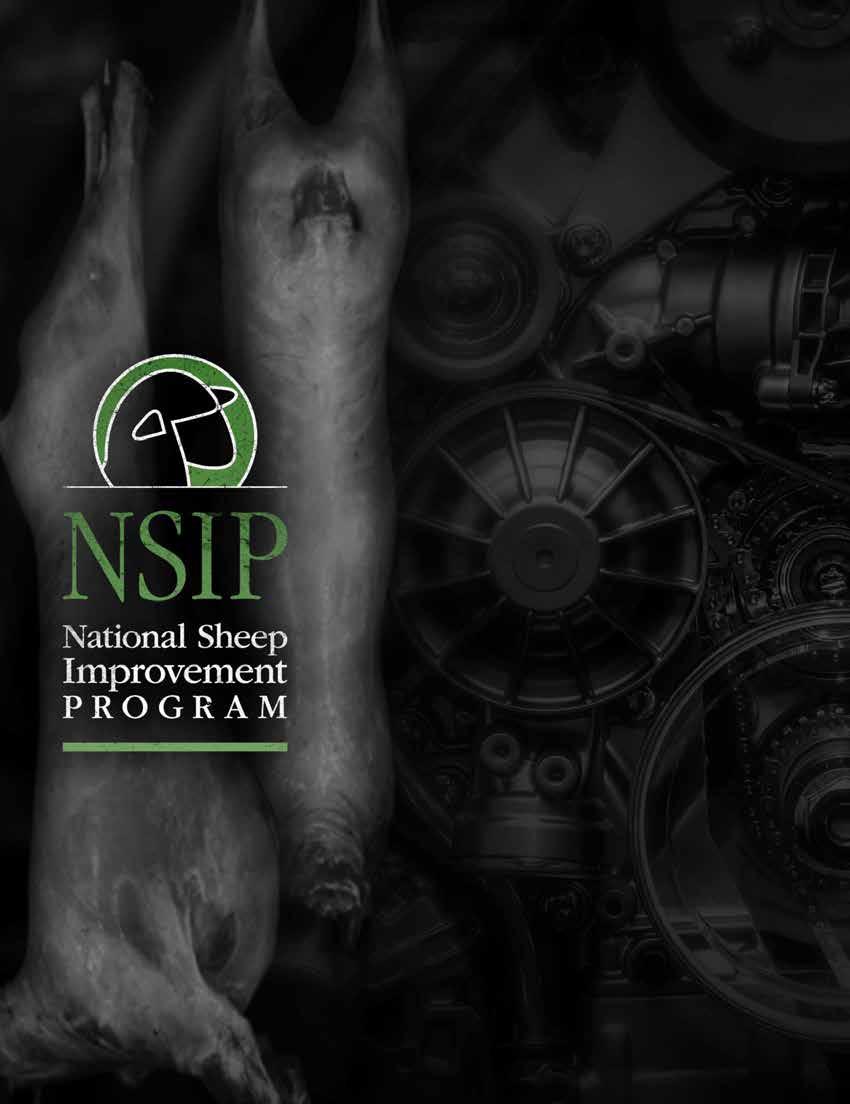
7 minute read
CAITLIN JACKSON from our executive director:

I proudly serve as the Executive Director of the American Dorper Sheep Breeders’ Society (ADSBS). I may be a little bias when I say that I have the best job in the world! I have the opportunity to promote, in my humble opinion, the best breeds of sheep because they possess the all-around traits that offer unparalleled value to the U.S. sheep industry that are necessary to profitability.
Advertisement
Dorpers bring immense value into a sheep operation with their powerful maternal and terminal traits. You can expect that these sheep will work for you and are very prolific with twinning rates easily achieved. Dorpers make excellent mothers and while they do well in all lambing-type operations they excel in pasture-lambing and are also nonseasonal breeders. No matter your type of operation they will work in your production system for your target markets without difficulty. You will continuously be impressed by the rapid growth rates that Dorpers possess and your lambs will get to market weight quickly and efficiently. Their carcass conformation is outstanding and once you try Dorper lamb you will never want to consume any other type of protein. If your target market is direct-to-consumer your customers will praise the flavor profile of Dorper lamb and you will soon have a line wrapped around the block.
Dorpers are also easy to manage and excel in pasture-based operations and do well in multispecies grazing systems as they are non-selective grazers. Adaptability is another important characteristic that Dorpers are well known for and are not only present in every state of the U.S. but thriving. You’ll also be very appreciative of their ability to shed which decreases your labor costs tremendously in comparison to wool-breeds. It should be of no surprise that Dorpers have risen to the top in popularity in all sizes of sheep operations. From small hobby flocks to largescale commercial flocks Dorpers are becoming a major influence in the U.S. sheep industry
ADSBS is the official registry of Dorper and White Dorper sheep in the U.S. and the Society has experienced unbelievable growth in membership and sheep registrations. This growth in popularity and excitement has led to record-setting sales which continuously fuels the fire of demand for Dorpers. We take pride in our mission to grow demand for Dorper and White Dorper sheep by delivering modern and efficient member services and registry that support traditional and progressive producers in areas of marketing, education, branded programs and genetic improvement.

Help us accomplish our vision to be the leading sheep breed organization that’s committed to increasing profitability and sustainability of the Dorper and White Dorper breeds by becoming a member and be active in the Society. There are many opportunities to get involved and become a change-maker. Check out our website and social media to see the latest news and upcoming events and make plans to join in. I truly believe that our greatest resource is our membership, and you have the skillset that we need to continue to grow our breeds. Please feel free to reach out to me if you would like to learn more about the versatility of Dorper and White Dorper sheep or have any questions about ADSBS.

See “ewe” around!
Caitlin B. Jackson
Thank you to the Clay Cowdrey Family of Mirror C Livestock for purchasing their Champion White Dorper Ram-NK 2090, that was later named Reserve Supreme behind INNOVATION...and also, pictured to the right , are the Hohertz family of Early, TX on purchasing NK 953, that was champion from the Texas Hill Country show and sale, and he was the Grand Champion White Dorper ram at the 2021 N.A.I.L.E (top 5 for Supreme), and Junior Champion Ram at Fort Worth... AND FINALLY, THANK YOU SBAR-T Livestock for purchasing the FIRST record breaking ewe of 2022 at the Mid America show and sale in Duncan, OK– NK 2076. THANK YOU TO ALL OUR CUSTOMERS! YOU’RE THE BEST!!!






Founded in 1986, National Sheep Improvement Program (NSIP) is committed to helping U.S sheep producers improve profitability through the use of genetic information. NSIP provides predictable, economically important genetic evaluation

Examples of Genotypes
• RR at codon 171
• NN for spider lamb syndrome
• EBV
Why Use EBVs?
and carcass traits) are in the 25-45% heritability range, which means 55- 75% of what you see with visual appraisal alone is due to environmental factors, and not genetics. Genetic evaluation programs like NSIP weed out the environmental influences and help breeders identify animals with superior genetics.
Estimated Breeding Values
Genetics are passed from parent to offspring but environment is not. Even the most highly heritable traits (like growth information to enrolled flocks by converting performance records into relevant decision-making tools. This allows NSIP members to combine this genetic evaluation along with visual assessments when selecting breeding stock for purebred and commercial flocks. NSIP is the only U.S. organization to offer sheep producers a proven genetic selection system by which to improve flock productivity and quality.
Genotype vs. Phenotype
For sheep, quantitative genetics are described through Estimated Breeding Values (EBVs). To have the best understanding of quantitative genetics, it is essential to understand phenotype and genotype.
PHENOTYPE: An animal’s phenotype (how it looks, how it performs) is a combination of genetics and environment.
PHENOTYPE = GENETICS + ENVIRONMENTAL INFLUENCE
GENOTYPE: The genetic makeup of an animal, usually derived from a DNA test or a genetic evaluation.
Example of Phenotypes:
• Structural correctness
• Actual weaning weight and yearling weight
• Loin eye area
• Type of birth
• Body condition score
EBVs are science- based, industry- tested measurements of heritable traits that can be tracked and measured. NSIP develops Estimated Breeding Values (EBVs) which sheep producers can use to select animals for important traits, including productivity, quality and flock health. EBVs are used to measure the genetic merit of individual animals for those traits financially important to commercial sheep production.
HERITABILITY is the percentage of an animal’s observed or measured phenotype due to genetics. This varies by trait. Even in the more highly heritable traits, most of the observed or measured difference in individual animal performance is due to environment.
• Birth weight 16%
• Weaning weight (60 days of age) 15%
• Post Weaning Weight (120 days of age) 28%
• Mature body weight 40%
• Multiple births 10%
• Milk production 10%
• Loin eye area 35%
• Fat thickness over loin eye area 30%
Many economically important traits cannot be evaluated simply by looking at the animal or production records. Using EBVs is the proven method of accurately predicting if an animal will pass on important traits such as growth rate, reproductive proficiency, carcass quality, and parasite resistance. By using EBVs, breeders can get an idea of how an individual will perform, which is helpful in designing a breeding program where the environmental factor is eliminated. Producers can compare individuals based on genetic merit from flocks across the country.
EBV & EPD
For those familiar with EPDs used in cattle, EBVs are very similar. EPDs denote the breeding value of an individual animal’s progeny, whereas EBVs denote the value of the individual animal.
An animal with a Postweaning Weight EBV of +6 will have an EPD of +3. Since NSIP EBVs are expressed in Kilograms (kg), we can convert the EBV to pounds by multiplying by 2.2 lbs per kg. A shortcut is to just view the EBV in kg as essentially the EPD in lbs as it will be within 10% of the value. So, it would be expected that a ram with a Postweaning weight EBV of +6 would sire lambs that would be 6 lbs heavier at post - weaning than lambs sired by the average ram.
Dorper /White Dorper EBVs
Growth: EBV or weaning (WWT) and postweaning weight (PWWT) can be used to select faster growing animals. Adjustments are made to account for litter size and lamb sex.
Loin eye muscle depth (EMD) EBV (mm): indicator of muscle from ultrasound loin muscle depth measurements between the 12th and 13th ribs in live animals, adjusted to the standard postweaning weight of 110 lbs. A positive Loin Eye Muscle Depth EBV should produce offspring with larger loin eyes.
Fat depth (FAT) EBV (mm): is an indicator of fat between the 12th and 13th rib in live animals, adjusted to the standard postweaning weight of 110 lbs. A negative FD EBV should produce leaner progeny with lower, more desirable yield grades.
Worm Egg Count: intended for selecting sheep with parasite resistance. EBVs include weaning (WWEC) and postweaning (PFEC) fecal egg count.
Maternal Traits: Number of lambs born (NLB) and number of lambs weaned (NLW) can be used by breeders to optimize lamb production.
SRC Index: The self-replacing carcass index (SRC) combines growth, carcass, parasite resistance and reproductive ability into a single value for comprehensive genetic selection of multi-purpose sheep.
Customizable Options
Producers can design their breeding program to focus on using the EBVs that will help them to best achieve the goal they have set for their flock. NSIP offers a Searchable Database that includes all animals enrolled in the program. This is a helpful tool in identifying breeding stock with EBVs that may be useful in a breeding program. The database can be accessed by anyone, not just NSIP members, and can be found at http://nsip.org/searchable-database
Enroll
Visit the NSIP website to find more about the enrollment costs and application process.
Free flock data management software.
Free training and mentoring support from a like-minded sheep breeder.
Advanced genetic evaluation calculations.
Comprehensive reports on individual animals and breeds.
Listing on NSIP website.
Option to consign to NSIP sales.
News and updates via email.
Requirements
To participate the required information for Dorper/White Dorper that must be recorded:
• Sire and Dam
• Birthdate, type of birth, and rearing
Dorper and White Dorper sheep do not need to be registered to be enrolled in NSIP.
Connect nsip.org
Jake Thorne, Dorper/White Dorper
Breed Representative, NSIP Board of Directors – Jake.Thorne@ag.tamu.edu
Rusty Burgett , NSIP Program Directorinfo@nsip.org
➔Find NSIP Breeding Stock at the Center of the Nation Sale July 30th in Spencer, Iowa or NSIP Terminal Sire Online Sale July 12th @wlivestock.com!
More Breeders Across the US are Turning to NSIP
Producers enrolled in NSIP have many tools at their disposal to evaluate their breeding decisions and track progress. Enrollment in NSIP by Dorper/White Dorper breeders in the US is rising and the value of this technology will only increase with expanded participation. A complete list of Dorper and White Dorper flocks in NSIP can be found at http://nsip.org/dorper-breeders/










